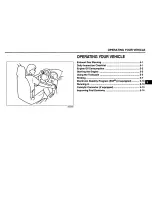
• Check that the latch plates and buckles work smoothly and the belts
retract easily. If a belt does not retract easily, cleaning the belt may
correct the problem. Only use mild soap and warm water. Do not use
bleach or cleaning solvents. Make sure the belt is completely dry before
allowing it to retract.
Any belt that is not in good condition or working properly will not provide
proper protection and should be replaced as soon as possible.
A belt that has been worn during a crash may not provide the same level of
protection in a subsequent crash. Have your seat belts inspected by a
dealer after any collision.
Not checking or maintaining seat belts can result in serious injury or death
if the seat belts do not work properly when needed.
Check your seat belts regularly and have any problem corrected as soon
as possible.
n
Fastening a Seat Belt
Adjust your seat to the proper position and then follow the steps below:
1. Pull the seat belt out slowly.
2. Insert the latch plate into the
buckle, then tug on the belt to make
sure the buckle is secure. Make
sure that the belt is not twisted or
caught on anything.
SAFETY INFORMATION
6 |
3. Position the lap part of the belt as
low as possible across your hips,
then pull up on the shoulder part of
the belt so the lap part fits snugly.
This lets your strong pelvic bones
take the force of a crash and
reduces the chance of internal
inquiries.
4. If necessary, pull up on the belt
again to remove any slack, then make sure that the belt rests across the
center of your chest and over your shoulder. This spreads the forces of a
crash over the strongest bones in your upper body.
To release the belt, push the red PRESS button then guide the belt by hand
until it has retracted completely.
Improperly positioning the seat belt can cause serious injury or death in a
crash.
Make sure all seat belts are properly positioned before driving.
n
Adjusting the Shoulder Anchor
The front seats have adjustable shoulder anchors to accommodate taller
and shorter occupants.
1. Move the anchor up and down
while pulling the release outward.
2. Position the anchor so that the belt
rests across the center of your
chest and over your shoulder.
Airbags
Your vehicle is equipped with several types of airbags: front airbags, side
airbags, and side curtain airbags.
n
Front Airbags (SRS)
The front SRS airbags inflate in a moderate-to-severe frontal collision to
help protect the head and chest of the driver and/or front passenger. They
are housed in the center of the steering wheel for the driver and in the
dashboard for the front passenger. Both airbags are marked SRS AIRBAG.
SAFETY INFORMATION
| 7








































